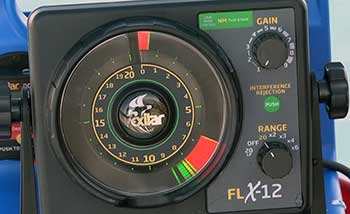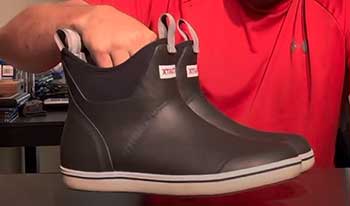If you’re an angler looking for a reel that punches above its weight, the Daiwa Fuego spinning reel is a no-brainer. For around $100, it delivers smooth performance, lightweight design, and durability that rivals pricier models.
I’ve spent countless hours casting with it, and it’s become my go-to for everything from bass to salmon. This reel’s blend of value and quality makes it a must-have for anyone serious about fishing without breaking the bank.
Trust me, you’ll want this in your tackle box.
My Journey With The Daiwa Fuego
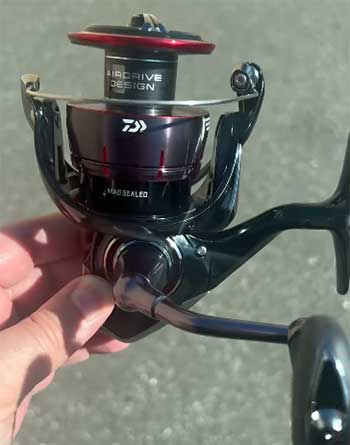
I still remember the day I unboxed my first Daiwa Fuego LT 3000.
It was a crisp spring morning, and I was itching to hit the lake for some largemouth bass. The reel felt surprisingly light in my hands, almost like it was begging to be cast.
I paired it with a medium-action rod and spooled it with 10-pound braided line, eager to see if the hype was real. From the first cast, I was hooked.
The retrieve was buttery smooth, and the drag held up against a feisty 3-pound bass that thought it could outsmart me.
Over the past four years, I’ve taken this reel everywhere—lakes, rivers, even piers in Michigan for salmon and steelhead.
It’s been dunked in water, dropped in sand, and still spins like it’s fresh out of the box.
What struck me most was how it handled the chaos of fishing.
One evening, I was pier fishing for coho salmon, and the Fuego’s drag system was put to the test. A king salmon hit my lure hard, peeling line like it was on a mission.
The drag was smooth, never jerking, letting me tire out the fish without losing control. I’ve also used it for finesse fishing, like targeting crappie with light jigs. The reel’s sensitivity let me feel every nibble, making it easy to set the hook.
Sure, it’s not perfect—there’s a slight flex in the body under heavy loads—but for the price, it’s hard to complain. I’ve since added a couple more Fuegos to my collection, and they’ve become my workhorses, outshining some pricier reels I’ve owned.
What Makes The Daiwa Fuego Stand Out?
The Daiwa Fuego LT is built around the “Light and Tough” philosophy, and it lives up to the name. Its Zaion V carbon-fiber body keeps it featherlight while holding up against the elements.
The Magsealed main shaft is a game-changer, blocking water and debris, which is a lifesaver for saltwater or gritty riverbanks. With a 6+1 bearing system, the reel spins effortlessly, and the Tough DigiGear ensures precision and durability. The Air Drive Rotor and Bail shave off extra weight, making long casting sessions feel less like a workout.
Available in sizes from 1000 to 6000, it’s versatile enough for ultralight trout or inshore reds. At roughly $100, it’s a steal for the tech packed inside.
Pros of The Daiwa Fuego
- Lightweight Design for All-Day Comfort
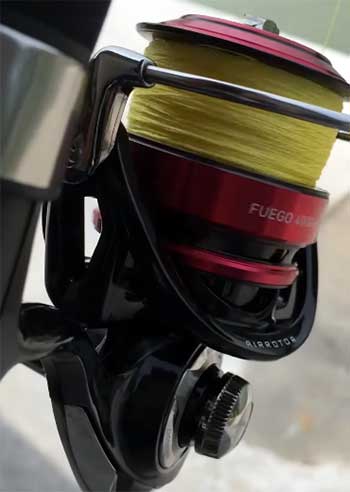
The Fuego’s carbon-infused body is a revelation.
At just 7.2 ounces for the 2500 model, it feels like an extension of your arm.
I’ve spent entire days casting for bass without the usual wrist fatigue I’d get from heavier reels.
This lightweight build doesn’t sacrifice strength, either.
The Zaion V material is tough enough to handle rough conditions, whether you’re fishing a rocky river or a salty pier.
You’ll appreciate this when you’re making hundreds of casts, chasing that one big bite.
- Silky-Smooth Retrieve
The 6+1 bearing system and Tough DigiGear make every turn of the handle feel effortless. I’ve reeled in everything from panfish to 9-pound redfish, and the Fuego stays smooth under pressure.
The retrieve is so fluid that it feels like a reel twice the price. Even after a full season of heavy use, I haven’t noticed any grinding or roughness, which is more than I can say for some other budget reels I’ve tried.
- Reliable Drag System
The drag on the Fuego is a standout. It’s smooth and adjustable, letting you fine-tune the pressure for everything from finesse fishing to battling hard-fighting fish.
I’ve landed 27-inch reds and even a 50-pound manta ray (talk about a surprise!) without the drag slipping or jerking. The max drag of 22 pounds on the 3000 model gives you confidence when a big fish hits.
You won’t be left scrambling when the line starts screaming.
- Saltwater-Ready with Magsealed Tech
The Magsealed main shaft is a feature you’d expect on a high-end reel, not one at this price. It keeps water, sand, and dirt out, which is crucial if you’re fishing inshore or surfing.
I’ve accidentally dunked my Fuego while kayaking, and it came out spinning like nothing happened. This durability means less maintenance and more time fishing, which is exactly what you want.
- Aesthetic Appeal
Let’s be honest—looks matter. The Fuego’s sleek black and red design (don’t worry, it’s not pink, despite what some photos suggest) turns heads at the dock. It’s got a premium vibe that belies its price tag.
I’ve had buddies ask if it’s a $300 reel, and I just smirk. Pair it with a sharp rod, and you’ve got a setup that’s as stylish as it is functional.
Cons of The Daiwa Fuego
- Slight Body Flex Under Heavy Loads
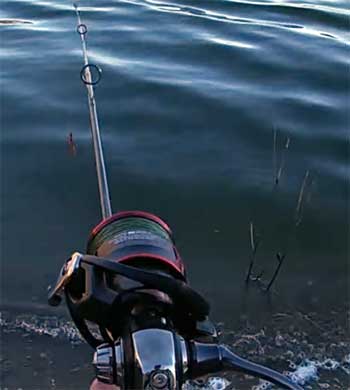
If there’s one thing that bugs me, it’s the slight flex in the reel’s body when I’m cranking against a big fish.
I noticed it when I hooked a 30-inch redfish, and the frame felt like it was giving a bit.
It didn’t break, but it’s not the rock-solid feel you’d get from a pricier reel like the Daiwa Tatula LT.
For most inshore fishing, it’s not a dealbreaker, but if you’re targeting monsters regularly, you might want to step up.
- Line Lay Issues with Braid
Spooling braid on the Fuego can be a bit finicky. On one of my reels, the line bunched up near the top of the spool, causing a few tangles. I fixed it by adding a washer to adjust the line lay, but it’s an extra step you might not expect.
Once dialed in, it casts like a dream, but you might need to tinker a bit out of the box.
- T-Handle Noise
The T-shaped handle on some models has a rubber grip that can make a faint popping noise when you’re reeling fast. It’s not a dealbreaker, but it’s annoying when you’re in the zone.
I swapped mine for an aftermarket aluminum handle, and it’s been smooth sailing since. If you’re sensitive to little quirks, this might bug you until you fix it.
- Durability Questions After Heavy Use
While the Fuego holds up well for its price, I’ve noticed the gears start to feel slightly less crisp after a full season of hard fishing. It’s still functional, but you can tell it’s not built for a lifetime like some premium reels.
For weekend warriors or casual anglers, this won’t be an issue, but if you’re fishing 100 days a year, you might need to replace it sooner than you’d like.
Maintenance Tips For Your Daiwa Fuego
- Rinse After Every Trip
Saltwater is a reel’s worst enemy, even with the Fuego’s Magsealed tech. After every trip, I rinse my reel under fresh water to flush out salt, sand, or dirt. Just hold it under a gentle stream, avoiding high pressure that could push water past the seals.
Pay extra attention to the spool and bail. A quick rinse takes 30 seconds and keeps your reel spinning smoothly for years.
- Lubricate Regularly
To keep that buttery retrieve, you need to oil the Fuego every couple of months, especially if you’re fishing saltwater. I use a lightweight reel oil on the main shaft, bail roller, and handle bearings. Don’t overdo it—a drop or two is enough.
For the gears, I apply a thin layer of reel grease during the off-season. This prevents corrosion and keeps everything moving like it should.
- Check Line Lay and Spool Tension
If you’re getting wind knots or uneven spooling, check the spool tension. I had this issue with braid and fixed it by adding a small washer under the spool. You can also adjust the tension by tightening or loosening the drag slightly while spooling.
Take your time when loading line, and use a bit of tension to ensure it lays evenly. It’s a small tweak that saves headaches later.
- Store Properly
When you’re not fishing, store your Fuego in a dry, cool place. I keep mine in a padded reel bag to protect it from bumps and dust. Avoid leaving it in direct sunlight or a damp tackle box, as that can degrade the materials over time.
If you’re in a humid area, toss a silica gel packet in with your gear to absorb moisture.
- Annual Deep Clean
Once a year, I give my Fuego a thorough cleaning. Disassemble the handle and spool (don’t go too deep unless you’re confident), and wipe down all accessible parts with a soft cloth. Check for any grit or corrosion, especially around the bail and rotor.
Re-lubricate sparingly and reassemble. If you’re not comfortable doing this, take it to a tackle shop. A pro can make it feel brand-new for a small fee.
Comparison of Daiwa Fuego Spinning Reel With Other Brands
- Daiwa Fuego Vs. Pflueger President Spinning Reel
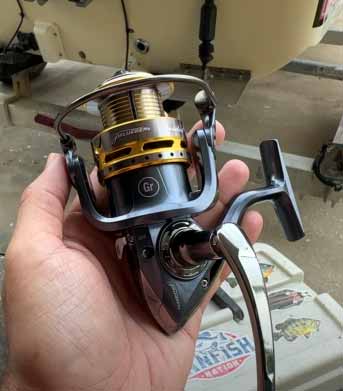
When I pit the Daiwa Fuego against the Pflueger President, the Fuego pulls ahead for its advanced tech.
The President, priced around $70, is a solid budget reel with a 10-bearing system that delivers a decently smooth retrieve.
I’ve used it for freshwater bass and walleye, and it’s reliable for light tackle.
However, its graphite body feels less refined than the Fuego’s Zaion V carbon-fiber frame, and at 8.1 ounces for the 2500 size, it’s noticeably heavier.
The Fuego’s Magsealed main shaft gives it a clear edge in saltwater or dirty conditions, while the President’s lack of sealing makes it better suited for clean lakes.
The President’s drag is adequate but lacks the Fuego’s finesse for big fish, topping out at 14 pounds compared to the Fuego’s 22.
If you’re a casual freshwater angler, the President saves you cash, but the Fuego’s versatility and durability make it worth the extra $30.
- Daiwa Fuego Vs. Shimano Nasci Spinning Reel
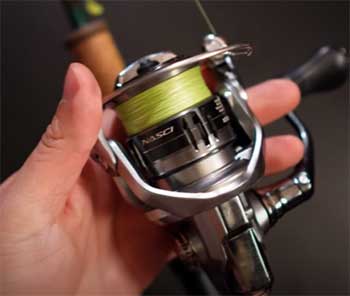
The Shimano Nasci is a fierce rival to the Fuego, and I’ve spent plenty of time with both.
Priced similarly at $100, the Nasci weighs 8.5 ounces for the 2500 model, heavier than the Fuego’s 7.2 ounces, which I notice after hours of casting.
The Nasci’s CoreProtect sealing helps with water resistance, but it’s not as effective as the Fuego’s Magsealed shaft at keeping out sand and salt.
The Nasci’s strength lies in its HAGANE gear, which feels a bit more robust under heavy loads, like when I’m fighting a 20-inch trout.
Its spool also handles braided line better, with fewer wind knots out of the box.
Still, the Fuego’s smoother retrieve and lighter feel give it the edge for finesse fishing or long sessions.
If you prioritize durability, the Nasci might tip the scales, but for all-around performance, I lean toward the Fuego.
- Daiwa Fuego Vs. ProFISHiency Pocket Combo

The ProFISHiency Pocket Combo is a unique comparison, as it’s a collapsible rod-and-reel setup aimed at portability, retailing around $60. I’ve taken the Pocket Combo on camping trips for ultralight fishing, and its 5.7-ounce reel (for the smallest size) is impressively compact.
However, its 5+1 bearing system and plastic-heavy construction can’t match the Fuego’s refinement. The Pocket Combo’s drag is jerky under pressure, and I’ve had it slip when landing a 2-pound bass, unlike the Fuego’s smooth 22-pound drag.
The Fuego’s carbon body and Magsealed tech make it far more durable for saltwater or rough conditions, while the Pocket Combo is best for occasional pond fishing. If you need a travel-friendly setup on a tight budget, the Pocket Combo is fun, but the Fuego is a serious reel for serious anglers.
Frequently Asked Questions (FAQ)
Fuego isn’t a standalone brand—it’s a line of spinning reels from Daiwa, a company with a stellar reputation in fishing gear. I’ve used Daiwa products for years, and the Fuego line is a testament to their knack for blending affordability with quality. The Fuego LT delivers high-end features like Magsealed tech and a smooth drag at a price that doesn’t sting. While it’s not perfect, it’s a fantastic choice for anglers who want performance without spending a fortune. Daiwa’s track record backs it up, so you’re in good hands with a Fuego.
For the Fuego, I swear by 10- to 15-pound braided line, like PowerPro or Daiwa J-Braid 8 Grand. Braid’s thin diameter and strength let you cast farther and handle big fish without overloading the reel. I use 10-pound braid for finesse fishing, like crappie or trout, and bump up to 15-pound for inshore reds or snook. If you prefer monofilament, go with 8- to 12-pound test for similar applications. Just make sure to spool it carefully to avoid line bunching, and consider adding a mono backing to save on braid.
This is the age-old debate, and honestly, it depends on what you value. I’ve fished with both Daiwa and Shimano reels extensively, and each has strengths. Daiwa, like the Fuego, often feels lighter and smoother for the price, with tech like Magsealed giving it an edge in saltwater. Shimano’s reels, like the Stradic, are known for their bulletproof durability and precise engineering. For budget-conscious anglers, I lean toward Daiwa because you get more features for less. But if you’re investing in a high-end reel, Shimano’s refinement is hard to beat. It’s a toss-up—try both and see what feels right.
Both the Daiwa Legalis LT and Fuego LT are lightweight spinning reels, but the Fuego is the step-up model. The Fuego has a 6+1 bearing system compared to the Legalis’ 5+1, making it smoother. Its Magsealed main shaft keeps out water and dirt, which the Legalis lacks, so the Fuego is better for saltwater or gritty environments. The Fuego also uses a more advanced Zaion V carbon body, slightly lighter and stronger than the Legalis’ carbon frame. Price-wise, the Legalis is about $20 cheaper, but the Fuego’s extra durability and refinement make it worth the upgrade if you fish often or in tough conditions.
Why The Daiwa Fuego Is A Must-Buy?
After years of fishing with the Daiwa Fuego, I can tell you it’s a reel that delivers way more than its $100 price suggests. It’s lightweight, smooth, and tough enough for everything from crappie to salmon.
Whether you’re a weekend angler or out on the water every day, this reel will keep up without letting you down. Grab one, hit the water, and see why it’s earned a permanent spot in my tackle box.
You won’t regret it.
